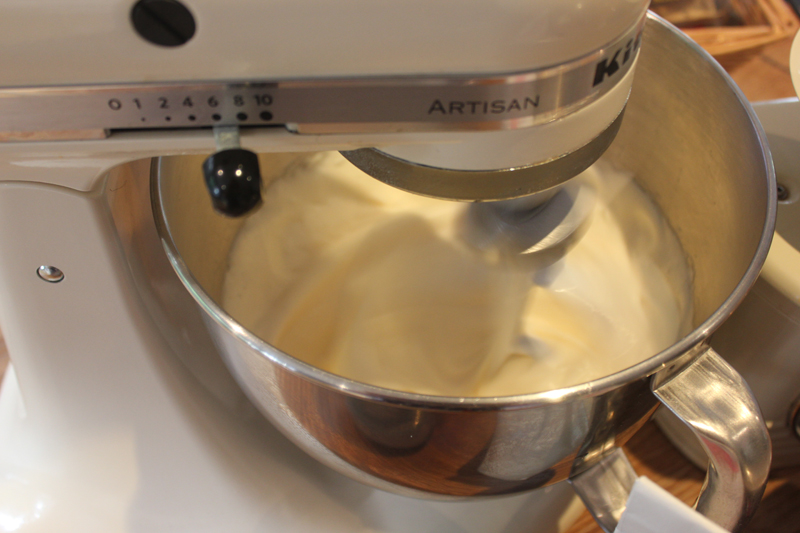You don’t need kitchen cupboards fit to bursting with all the newest, fanciest baking equipment to be a great home baker. But having a few good quality basics will set you well on your way to turning out great bakes, time after time. I have set out some of the key bits of kit you should consider buying to set yourself up well for baking yourself happy at home 🙂

BAKING TINS / PANS
There are baking tins out there for any and every size, shape and depth of cake. It can be mind-boggling! So my advice, if you are on a limited budget is to buy the best quality you can afford of an 8″ round, and 8″ square and an 8″x12″ brownie / traybake tin. There are soooooo many recipes written for these tin sizes, that you won’t be struggling for things to bake with just these three tins.
You will also need a 12-hole cupcake tray / muffin pan if you are going to be baking cupcakes (which are great fun to make with mini bakers and are a quick and simple way of getting a cake fix!)
And also a nice and solid and sturdy baking tray (if you are going to be big on cookie baking, buy at least one big one or two smaller ones that will fit side-by-side in your oven. Many cookie recipes require a lot of space between each cookie to allow for spreading while baking. If you only have one small tray, you are going to have to run your oven for a long time to get all your cookies baked).
Decide on your budget and then shop around to see what you can find. My recommendation would be to buy Alan Silverwood tins/pans if you can afford them. They are excellent quality and are made from anodised aluminium. Aluminium is a great bakeware material as it conducts/distributes heat evenly throughout the entire tin, leaving you with beautifully even bakes.
And they last. The Silverwood bakeware tins I use are easily 12 years old and still going as strong as they were on the day I bought them!
Aluminium bakeware, because it is light in colour, radiates heat more gently than dark coloured bakeware, which means your cakes won’t brown too quickly on the bottom and around the edges.
If you are reading this thinking ‘oh no, I already own some baking tins and they’re all dark’, don’t panic! They will still work. I am just sharing with you my preference and why I choose the tins I do.
ELECTRIC MIXER
If you are going to make baking a part of your life rather than just something you dabble in on a whim once or twice a year, then I would encourage you to think seriously about investing in a stand mixer.
I have more mixers than you could shake a stick at. But then I run a bakery so that’s perhaps not surprising!
I have a mahoosive commercial planetary mixer for large volume baking, but I also have three KitchenAid stand mixers. They’re not the cheapest bits of kit but they are really, really well made and will last and last.
I also have one of those old Kenwood mixers from circa 1960 something, which was handed down to me from my mother-in-law (it was originally her mother’s mixer!) And it still works a treat. Although let me tell you it’s loud. *Very* loud!
There are lots of other brands out there, including: Smeg, Cuisinart, Morphy Richards and more. Have a look at this useful guide to buying a stand mixer from BBC Good Food and check out its top recommendations.
Stand mixers have also been known to make an appearance in the ‘aisle of dreams’ at Aldi, so it’s always worth keeping an eye out there if you’re on a tight budget.
If a stand mixer is beyond your budget, then an electric hand mixer can still save you a lot of time and energy in the kitchen and will mean you can be sat down with a cup of tea and a slice of cake quicker than if you did absolutely everything by hand! It will also take up less space if you are struggling for worktop and/or storage space in your kitchen.


BALLOON WHISK
Balloon whisks are useful gadgets to have in your kitchen utensils drawer. You can use them to whisk your dry ingredients together, which will not only ensure even distribution of flours and raising agents, but will add air. And air helps to produce lighter cakes.
You can also use a balloon whisk to lightly beat/froth egg whites (quicker than using a fork) and to make lovely smooth sauces.
And if you don’t own an electric mixer, you will most definitely need a balloon whisk for making everything from meringues to whipped cream. And you will most likely develop rock solid arm muscles, for which I salute you!
I would strongly recommend buying a metal balloon whisk and not a silicone one. I find the silicone ones have too much ‘give’. When selecting your metal balloon whisk, gently squeeze the metal loops in your hand. If there’s a lot of give, put it back and seek out a more robust whisk. A better quality one will last much longer and will be quicker and easier to use as the metal loops won’t lose their shape and start to splay.
MICROWAVE-PROOF BOWLS / DISHES
Your microwave can be a very handy piece of equipment for melting butter and chocolate and warming up jams and sauces for drizzling.
Having a couple of microwave-safe bowls that you can use for these tasks saves your favourite home kitchenware from overuse/damage!


DIGITAL WEIGHING SCALES
Baking by weight is accurate. Baking by volume (cups) is not. Buying yourself a kitchen scale will, in this one small purchase, make you an instantly better baker.
You can pick one up for as little as £10. I would always recommend a digital kitchen scale for much better accuracy (which is critical when it comes to gluten-free bread baking!)
SPATULAS
My kitchen utensils trays are littered with spatulas. But then I bake every day, for hours at a time. For the avid homemaker, just a couple will suffice!
Get yourself a rubber / silicone spatula for scraping all the cake batter and buttercream out of your bowls and to get as much out of your ingredients as possible. They also make great mixing tools.
A metal offset spatula is also a really useful tool for spreading buttercream, jams, spreads and ganaches onto your cakes.


COOLING RACK
You will need a cooling rack to place your cakes and biscuits/cookies on once you have removed them from the tin/tray to allow them to properly cool (I know, I know, you just want to eat them *now*!)
Ideally, go for a fine mesh one as these are less likely to leave imprints on your cakes than the widely spaced ones. (I have a round one that leaves a spiral indent in the cakes I place on it. Very pretty but often not the look I am going for!)
FINE MESH SIEVE
You 100% need a sieve if you are baking anything that uses icing sugar. Icing sugar can easily clump and so you need to get rid of those pesky lumps before you add the sugar to your beaten butter if you want a silky smooth, lump-free buttercream.
Go for one of the fine mesh ones rather than a wide mesh or colander style sieve as they have a tendency to let some of the lumps through.


BAKING PAPER / PARCHMENT OR SILICONE LINERS
You will see that a lot of cake recipes call for you to grease and line your cake tins before adding the cake batter, so it’s good to have a roll of baking parchment in your kitchen cupboard. Make sure you use baking paper and NOT greaseproof paper. If you’re unsure of the difference, read my article on the difference between baking paper and greaseproof paper to make sure you are using the right stuff.
If you prefer to avoid single use materials, have a look for non-stick reusable cake tin / baking tray liners. Bake-O-Glide® is one such product and it is my go-to product to replace single-use baking paper at the bakery (and when I am baking at home). You can buy ready made strips and base liners to fit a range of cake tins and you can also buy it in sheets to cut down to the sizes you need.
ROLLING PIN AND SPACERS
If you are going to be working with pastry, biscuits or sugarpaste icing then you will need to have a rolling pin in your baking kit. At a push you can grab an old wine bottle (cleaned and minus any labels) but for a nice even roll-out a good quality pin is a must, I think.
Rolling pin spacers are an absolute game changer when it comes to achieving thin, evenly rolled pastry, biscuits and icing. They come in a range of different thicknesses so you can pick and choose which ones you use depending on what you are rolling out.
I sell both rolling pin spacers and a durable, non-stick rolling pin in my online shop, both of which I use at the bakery.


MEASURING SPOONS
For this, I mean a set of spoons that measure a tablespoon (1 tbsp), a dessert spoon (1 dsp), a teaspoon (1 tsp), a half teaspoon (1/2 tsp), a quarter teaspoon (1/4 tsp) and some, although not all, may have a ‘pinch’ spoon. I *do not* mean measuring cups. And please, for the love of all that is holy, if you have a set of measuring cups, relegate them to the cupboard of unwanted things (see my article on baking tips for why I say this!)
Ingredients that call for small quantities like a teaspoon are typically things like raising agents. And too much or too little of these can really knock a recipe out and turn a potential baking triumph into a bake fail. But if you have a set of accurately calibrated measuring spoons, you are much less likely to put too much or too little of an ingredient into your bake.
FRUIT ZESTER AND JUICER
If, like me, you’re a big fan of zesty cakes, cookies and desserts, then you’re going to need both a fruit zester and a fruit juicer for all those citrusy bakes you’re going to make!
One of my best kitchen gadgets is the Oxo Good Grips lemon zester. It’s a game changer! No more grated knuckles and leaving half the fruit zest on the grater. I urge you to get one 🙂
There is a goodly amount of choice when it comes to fruit juicers, from whizzy electrical ones to the most basic of manual squeezers. I have the latter…the two piece sort with the pointy top half that you press and twist your fruit onto to extract the juice and the tray underneath it to collect the juice.


PASTRY BRUSH
You will need a pastry brush for a whole host of baking tasks including: egg-washing pastry and scones, glazing pastries and greasing tins.
They are available as bristle brushes and silicone. I find the silicone ones worse than useless and would recommend you buy a bristle brush. Always wash thoroughly after use in hot soapy water.
ICING TIPS / NOZZLES
There are 100s of icing tips and piping nozzles out there and for every different shape there are probably several different sizes!
But unless you’re planning on going into business make cakes with piped icing, then you will be good to go with just one or two. The two I use most in the bakery are the 1M drop flower piping tip (which I sell in my online shop) and also a round baking tip.
The 1M tip is perfect for creating classic buttercream swirls for cupcakes and the round tip can be used for piping buttercream teardrops, meringue, choux pastry and more.


PIPING BAGS
If you’re going to be piping buttercream, ganache or cream (and some soft biscuit doughs), then you will need a piping bag.
You can buy both reusable / washable ones and disposable ones. You can also buy icing sets, which typically come with a reusable bag, several tips and a coupler. A coupler is a little attachment that enables you to switch your piping tip without having to switch to a new bag with fresh icing in. I sell 18″ disposable piping bags in my online shop.








